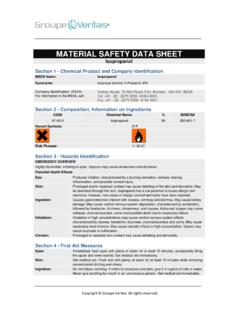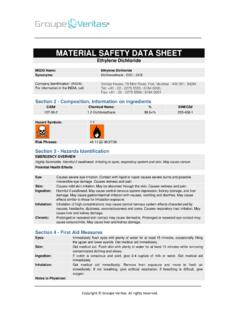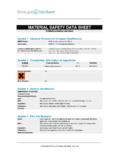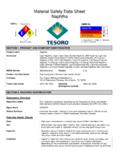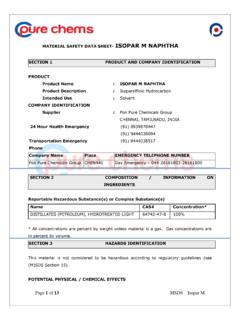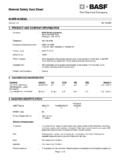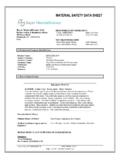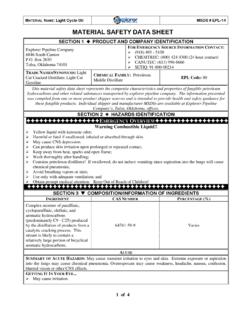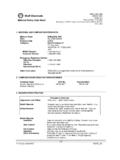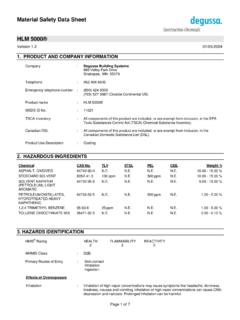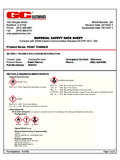Transcription of MATERIAL SAFETY DATA SHEET
1 MATERIAL SAFETY data SHEET . naphtha . 1. Chemical Product And Company Identification PRODUCT NAME : naphtha . Identification of the substance: SOLVENT naphtha . Chemical family: Hydrocarbon CAS No: 64742-94-5. EINECS No: 265-198-5. Product description: Clear, colorless liquid No.: 1268. NFPA hazard rating: IMO hazard group: 3. Stationary phase: Liquid Solubility in water: Insoluble Company Identification: (INDIA) Veritas House, 70 Mint Road, Fort, Mumbai - 400 001. INDIA. For information in the INDIA, call: Tel: +91 - 22 - 2275 5555 / 6184 0000, Fax: +91 - 22 - 2275 5556 / 6184 0001. 2. Composition/Information on Ingredients EINECS Number: 265-198-5. CAS Number: 64742-94-5. Components Or Ingredients: C5-C10+ ALKYL AROMATICS MIXTURE OF.
2 ISOMERS. R-phrase: R37 , R20/21, R36/37/38. 3. Hazards Identification Physical And Chemical Hazards / Fire And Explosion Hazards Moderate hazard: Liquids can release vapors that can readily form flammable mixtures upon moderate heating to temperature at or above the flash point Static discharge: Product can accumulate static charges which can cause an incendiary electrical discharge. 4. First Aid Measures Inhalation: Using proper respiratory protection, immediately remove the affected victim from exposure. Administer artificial respiration if breathing is stopped. Keep at rest. Call for prompt medical attention Skin Contact: Flush with large amounts of water; use soap if available. Remove contaminated clothing, including shoes, after flushing has begun If irritation persists, get medical attention Eye Contact: Flush eyes with large amounts of water until irritation subside.
3 If irritation persists, get medical attention Ingestion: If swallowed, DO NOT induce vomiting. Keep at rest. Get Copyright Groupe Veritas. All rights reserved. prompt medical attention. 5. Fire Fighting Measures Fire Fighting Procedures: Use water spray to cool fire exposed surfaces and to protect personnel. Shut off "fuel" to fire. If a leak or spill has not ignited, use water spray to disperse the vapors and to protect men attempting to stop a leak. Use foam or dry chemical to extinguish fire Special Fire Precautions: Avoid spraying water directly into storage containers due to danger of boiler. See also section 4 "FIRST AID. MEASURES" as well as section 10 "STABILITY AND. REACTIVITY". Hazardous Combustion No unusual Products: 6.
4 Accidental Release Measures Land Spill: Eliminate sources of ignition. Warn occupants of down wind areas of fire and explosion hazard. Prevent liquid from entering sewers, watercourses, or low areas. Keep public away. Shut off source if possible to do so without hazard. Advise police if substance has entered a watercourse or sewer or has contaminated soil or vegetation. Take measures to minimize the effect on the ground water. Contain spilled liquid with sand or earth Recover by pumping (use an explosion proof or hand pump) or with a suitable absorbent. If liquid is too viscous for pumping, scrape up with shovels or pails and place in suitable containers for recycle or disposal Consult an expert on disposal of recovered MATERIAL and ensure conformity to local disposal regulations.
5 See section 4 "FIRST AID MEASURES". as well as section 10 "STABILITY AND REACTIVITY". Water Spill: Eliminate sources of ignition. Warn occupants and shipping in downwind areas of fire and explosion hazard and request them to stay clear. Notify port or relevant authority and keep public away. Shut off source if possible. Remove from surface by skimming or with suitable absorbents. If allowed by local authorities and environmental agencies sinking and/or suitable dispersants may be used in non- confined waters. Consult an expert on disposal of any recovered MATERIAL and ensure conformity to local disposal regulations. See also section 4 "FIRST AID. MEASURES" and section 10 "STABILITY AND REACTIVITY". 7. Handling and Storage Storage Temperature (Deg cel) Ambient Transport Temperature Deg cel) Ambient Loading/Unloading Temperature (Deg Ambient cel).
6 Viscosity (cSt) Storage/Transport Pressure (Kpa) Atmospheric Electrostatic Use proper grounding procedure. Usual Shipping Containers Tank cars , tank trucks, tankers, barges, drums Materials And Coatings Suitable Carbon Steel, Stainless Steel, Polyester, Teflon Materials And Coatings Unsuitable Natural Rubbers, Butyl Rubber, EPDM, Polystyrene, Polyethylene, Polypropylene, Polyvinyl chloride, Polyvinyl alcohol, Polyacrylonitrile Compatibility with Plastic Materials can vary; we therefore recommend that compatibility is tested prior to use. Copyright Groupe Veritas. All rights reserved. Storage / Handling, General Notes Keep container closed. Handle containers with care. Open slowly in order to control possible pressure release.
7 Store in a cool, well-ventilated place away from incompatible materials. Do not handle, store or open near an open flame, sources of heat or sources of ignition. Protect MATERIAL from direct sunlight. MATERIAL will accumulate static charges which may cause an electrical spark (ignition source). Use proper grounding procedures. DO NOT pressurize, cut, heat or weld containers. Empty product containers may contain product residue. DO NOT reuse empty containers without commercial cleaning or reconditioning. 8. Exposure Controls/Personal Protection Workplace Exposure Limits: The use of local exhaust ventilation is recommended to control process emissions near the source. Laboratory samples should be stored and handled in a lab hood.
8 Provide mechanical ventilation of confined spaces. See respiratory protection recommendations. Use explosion- proof ventilation equipment. Occupational Exposure Limits: 50 ppm total hydrocarbon Personal Protection: For open systems where contact is likely, wear chemical resistant gloves, rubber boots, a chemical jacket and a face shield. Where contact may occur, wear long sleeves, chemical resistant gloves and a face shield. Where concentrations in air may exceed the limits given in this Section and engineering, work practice or other means of exposure reduction are not adequate, approved respirators may be necessary to prevent overexposure by inhalation. 9. Physical and Chemical Properties These are indicative values only.
9 Please refer also to the product specification SHEET . Physical State Liquid Form/Color Clear colorless liquid Odor Aromatic hydrocarbon odor Freezing /Melting Point deg cel Boiling Point Range 110-190 deg cel Flashpoint (Tcc) > 65 deg cel Autoignition Temperature > 420 deg cel Explosive Limits (In Air) - vol %. Vapor Pressure @ 20 C kPa Vapor Pressure @ 38 C kPa Vapor Pressure @ 55 C kPa Density @ 15 C g/cc Vapor Density (1013 Kpa/Air) > kPa Solubility In Water @ Degc < Wt%. Viscosity @ 25 C cSt Evaporation Rate (N-Bu Acetate=1). Copyright Groupe Veritas. All rights reserved. 10. Stability and Reactivity Hazardous Polymerization No Conditions To Avoid Polymerization Not Applicable Stability Stable Conditions To Avoid In-Stability Not Applicable Materials And Conditions To Strong oxidizing agents Avoid(Incompatibility): Hazardous Decomposition Products None 11.
10 Toxicological Information ACUTE: INHALATION: Vapor concentrations above recommended exposure levels may be irritating to the eyes and the respiratory tract, may cause headaches and dizziness, could be anesthetic and may have other central nervous system effects. SKIN CONTACT: - Low order of toxicity - Frequent or prolonged contact may defeat and dry the skin, leading to discomfort and dermatitis. EYE CONTACT: - Will cause eye discomfort, but will not injure eye tissue. INGESTION: - Small amounts of liquid aspirated into the respiratory system during ingestion or from vomiting may cause bronchopneumonia or pulmonary edema. - Minimal toxicity. Additional information is available on special request 12. Ecological Information Environmental Mobility Henry's Law Constant (Pa-M3/Mole).


